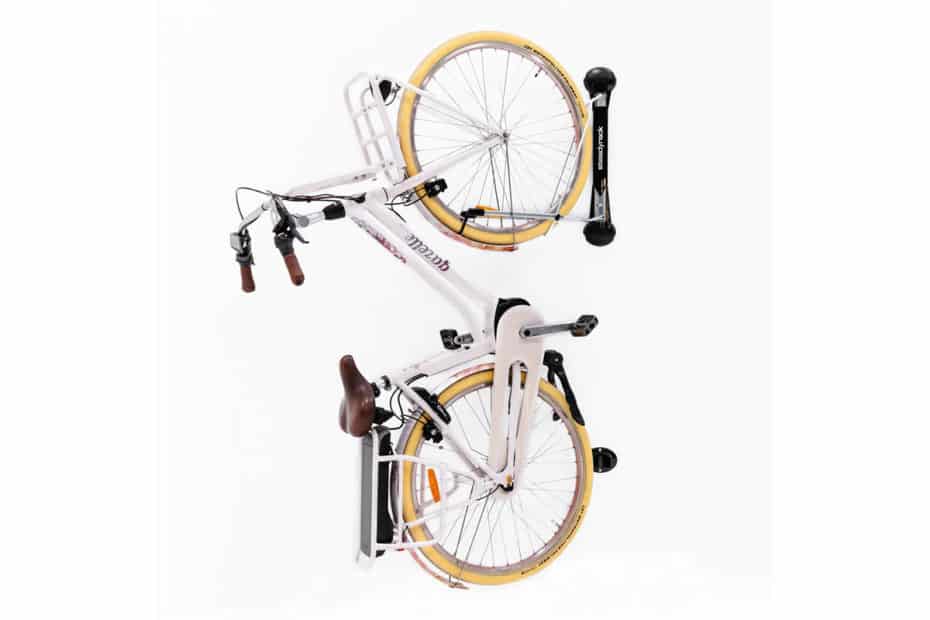Whether due to lack of space or simply because of the coolness factor – some people like to hang their bike on the wall at home instead of placing it on the floor. If you do this with an ebike, you need a wall mount that is approved for correspondingly high payloads. Like, for example, the new eBike rack from Steadyrack.
Annoyance productively transformed
The company from faraway Australia has been on the market with its mounts since 2009. According to founder and current CEO David Steadman, he was fed up at the time with the rest of his family parking their bikes around by the walls or even on the floor of the garage. At the same time, however, it was also clear that wife and children should not permanently heave their two-wheelers up onto alternatives such as massive wall hooks.
As a solution, with the creative help of his father-in-law, he invented a wall bracket onto which a bicycle can basically simply be pushed. So far, there have been four different versions:
- Classic Rack for road bikes,
- MTB Rack for mountain bikes of all kinds,
- Fender Rack for bicycles with mudguards and
- and Fat Rack for fat bikes with the corresponding extremely wide tyres.
Enormously loadable
Now, for the first time, there is a rack explicitly for ebikes. The eBike Rack combines various features of the aforementioned. This version is suitable for ebikes with wheels in sizes from 20″ to 29″. The tyres may be between 2.1 inches and 2.8 inches wide. Furthermore, it does not matter whether mudguards are installed on the ebike or not. The eBike Rack can handle both options. The only requirement Steadyrack mentions is a minimum distance from the front tyre to the down tube, which should be at least two centimetres.
However, the decisive feature of the eBike Rack is its load capacity of 35 kilograms per rack. In many cases, this means that you can even leave two batteries on the ebike before hanging it up. Even ebikes that are a little heavy from the very beginning, such as the new Upstreet from Flyer with its 32 kilograms, are no problem.
A question of technique
The weight of the ebike is not so important when it comes to hitching it up. Contrary to what you might think, you don’t need to lift it at all. While you pull the rear brake, you place the bike on its rear wheel and roll it towards the wall bracket. The front wheel slides into a rail. While you continue to push the bike slightly towards the wall, it will finally roll into the correct position.
By applying the right technique, this can be done without any significant effort. The design of the rack takes advantage of the fact that a wheel usually rolls. This applies to parking as well as to taking the bike down from the wall. The front wheel of the ebike rests on the wall in the rail mentioned above. In this way, the weight is distributed over a wide area and is not concentrated on just one spoke, as is perhaps the case with cheaper designs. In addition, the rear wheel locks into a small, special mount.
- The rail for the front wheel
- The eBike Rack folded up
If you release the rear wheel from this mount, the entire ebike can even be swivelled so far towards the wall until the handlebars put an end to it. The rail for the front wheel is equipped with a pivot that you can turn by a maximum of 160 degrees. Depending on where the bike is hanging, it can quickly get out of the way in this way. At the same time, you can mount several bicycles relatively close to each other on a wall and still get to each individual bicycle by swivelling the others aside. Remotely, this is reminiscent of turning the pages of a book.

Mounted at different heights, several bikes fit comfortably next to each other in the smallest space.
Free choice of place
The necessary accessories for mounting the eBike Rack, i.e. screws and dowels, are supplied by Steadyrack. If your wall requires a more special solution, you can buy a few alternatives at the DIY store to replace the dowels provided. Basically, however, any load-bearing vertical surface is suitable, be it a wall, a pole, a door or whatever.
Steadyrack currently charges around 75 euros for a mount. Delivery is even free of charge to several destinations worldwide including Germany.
Pictures: Steady Corp Pty Ltd






